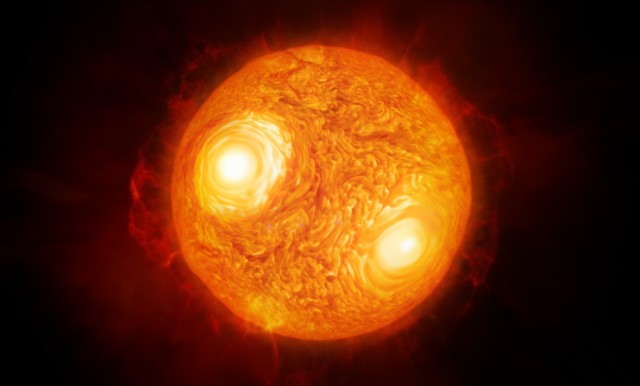
An article published in the journal “Nature” describes the creation of the most detailed image of the surface and atmosphere of a star other than the Sun. A team of astronomers led by Keiichi Ohnaka of the Universidad Católica del Norte in Chile used the Very Large Telescope Interferometer (VLTI) to achieve this result with the red supergiant Antares. It’s also the first map of the materials that make up the atmosphere of a star other than the Sun.
Antares is well-known because it’s the brightest star of the constellation of Scorpius and the fifteenth star for brightness in the night sky. Just over 550 light years away from Earth, its mass is estimated around 12 solar masses but its volume is now enormously expanded so its diameter is about 700 times the Sun’s. It’s passing through the final phase of its agony and when it starts to contract again at the end of its red supergiant expansion period it will end up exploding in a supernova.
These massive dying stars are very interesting to study to understand the complex and chaotic processes they’re passing through. VLTI is an excellent instrument to observe Antares because it uses the interferometry technique to combine the light captured by different telescopes, in this case up to 4, to obtain a kind of virtual telescope that is equivalent to a mirror with a diameter of up to 200 meters. This allows to get much better details than any single telescope.
One of the problems studied using VLTI is Antares’ mass loss. According to astronomers, its original mass was to be around 15 solar masses, which means that it has lost a lot of it. The observations allowed to map the speed of the materials in the atmosphere of this red supergiant, including the differences in velocity of the atmospheric gas in different areas and the overall average speed. So far, such a goal had been achieved only with the Sun.
The data collected indicate that turbulent low-density gas is much farther than expected from the star. The astronomers concluded that it couldn’t have been generated from convection, meaning from large-scale movement of materials that in many stars transfer energy from the core to the outer atmosphere. They think that there’s another unknown process in progress that could explain those movements in the atmosphere of red supergiants.
Keiichi Ohnaka explained that the observation technique used to study Antares can be applied to different types of stars to study their surface and atmosphere with unprecedented details. This is a work that brings stellar astrophysics to a new dimension and opens a new window to observe stars.


